Marketing Mix: Integrated Customer Experience Analysis for Business
VerifiedAdded on 2021/06/14
|12
|3475
|42
Report
AI Summary
This report delves into the critical relationship between the marketing mix and customer experience in the contemporary business landscape. It emphasizes the importance of integrated customer experience as a core component of any successful marketing strategy, highlighting the need for companies to create products and services that resonate with consumers to build brand loyalty and gain a competitive edge. The report examines the various facets of customer experience, from direct interactions to indirect influences like advertising, and explores how positive experiences, driven by factors such as customer service, ethical practices, and engaging environments, contribute to higher brand equity and market leadership. The report also discusses the techniques and strategies, including personal selling, public relations, and the effective use of the marketing mix (product, price, promotion, place), that companies can employ to cultivate and enhance customer experiences, ultimately aiming to boost sales and counter the competitive nature of the global market. The analysis is supported by a literature review of seventeen references, including scholarly articles and academic books.

Running head: MARKETING 1
Marketing mix
Name:
Institution:
Marketing mix
Name:
Institution:
Paraphrase This Document
Need a fresh take? Get an instant paraphrase of this document with our AI Paraphraser
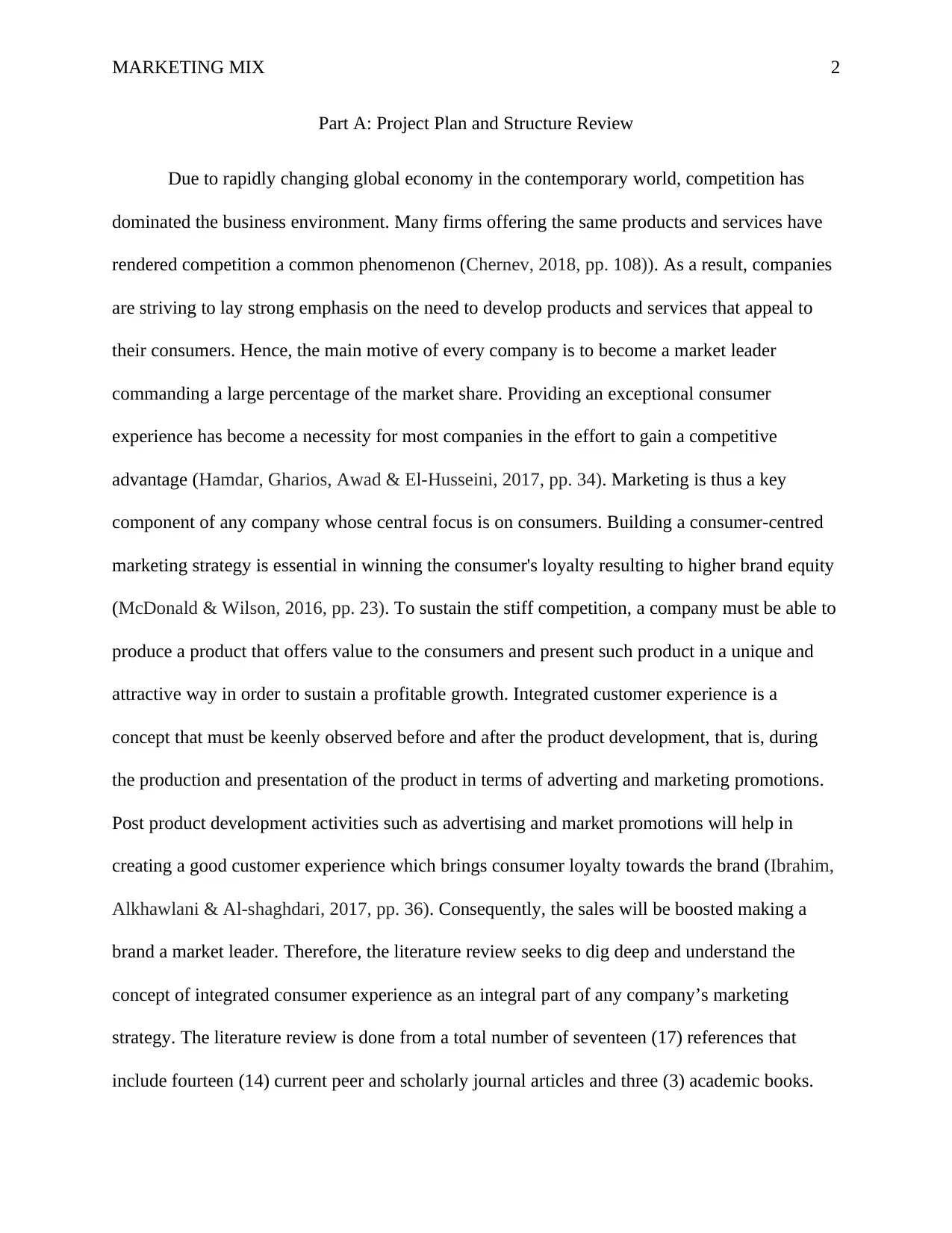
MARKETING MIX 2
Part A: Project Plan and Structure Review
Due to rapidly changing global economy in the contemporary world, competition has
dominated the business environment. Many firms offering the same products and services have
rendered competition a common phenomenon (Chernev, 2018, pp. 108)). As a result, companies
are striving to lay strong emphasis on the need to develop products and services that appeal to
their consumers. Hence, the main motive of every company is to become a market leader
commanding a large percentage of the market share. Providing an exceptional consumer
experience has become a necessity for most companies in the effort to gain a competitive
advantage (Hamdar, Gharios, Awad & El-Husseini, 2017, pp. 34). Marketing is thus a key
component of any company whose central focus is on consumers. Building a consumer-centred
marketing strategy is essential in winning the consumer's loyalty resulting to higher brand equity
(McDonald & Wilson, 2016, pp. 23). To sustain the stiff competition, a company must be able to
produce a product that offers value to the consumers and present such product in a unique and
attractive way in order to sustain a profitable growth. Integrated customer experience is a
concept that must be keenly observed before and after the product development, that is, during
the production and presentation of the product in terms of adverting and marketing promotions.
Post product development activities such as advertising and market promotions will help in
creating a good customer experience which brings consumer loyalty towards the brand (Ibrahim,
Alkhawlani & Al-shaghdari, 2017, pp. 36). Consequently, the sales will be boosted making a
brand a market leader. Therefore, the literature review seeks to dig deep and understand the
concept of integrated consumer experience as an integral part of any company’s marketing
strategy. The literature review is done from a total number of seventeen (17) references that
include fourteen (14) current peer and scholarly journal articles and three (3) academic books.
Part A: Project Plan and Structure Review
Due to rapidly changing global economy in the contemporary world, competition has
dominated the business environment. Many firms offering the same products and services have
rendered competition a common phenomenon (Chernev, 2018, pp. 108)). As a result, companies
are striving to lay strong emphasis on the need to develop products and services that appeal to
their consumers. Hence, the main motive of every company is to become a market leader
commanding a large percentage of the market share. Providing an exceptional consumer
experience has become a necessity for most companies in the effort to gain a competitive
advantage (Hamdar, Gharios, Awad & El-Husseini, 2017, pp. 34). Marketing is thus a key
component of any company whose central focus is on consumers. Building a consumer-centred
marketing strategy is essential in winning the consumer's loyalty resulting to higher brand equity
(McDonald & Wilson, 2016, pp. 23). To sustain the stiff competition, a company must be able to
produce a product that offers value to the consumers and present such product in a unique and
attractive way in order to sustain a profitable growth. Integrated customer experience is a
concept that must be keenly observed before and after the product development, that is, during
the production and presentation of the product in terms of adverting and marketing promotions.
Post product development activities such as advertising and market promotions will help in
creating a good customer experience which brings consumer loyalty towards the brand (Ibrahim,
Alkhawlani & Al-shaghdari, 2017, pp. 36). Consequently, the sales will be boosted making a
brand a market leader. Therefore, the literature review seeks to dig deep and understand the
concept of integrated consumer experience as an integral part of any company’s marketing
strategy. The literature review is done from a total number of seventeen (17) references that
include fourteen (14) current peer and scholarly journal articles and three (3) academic books.
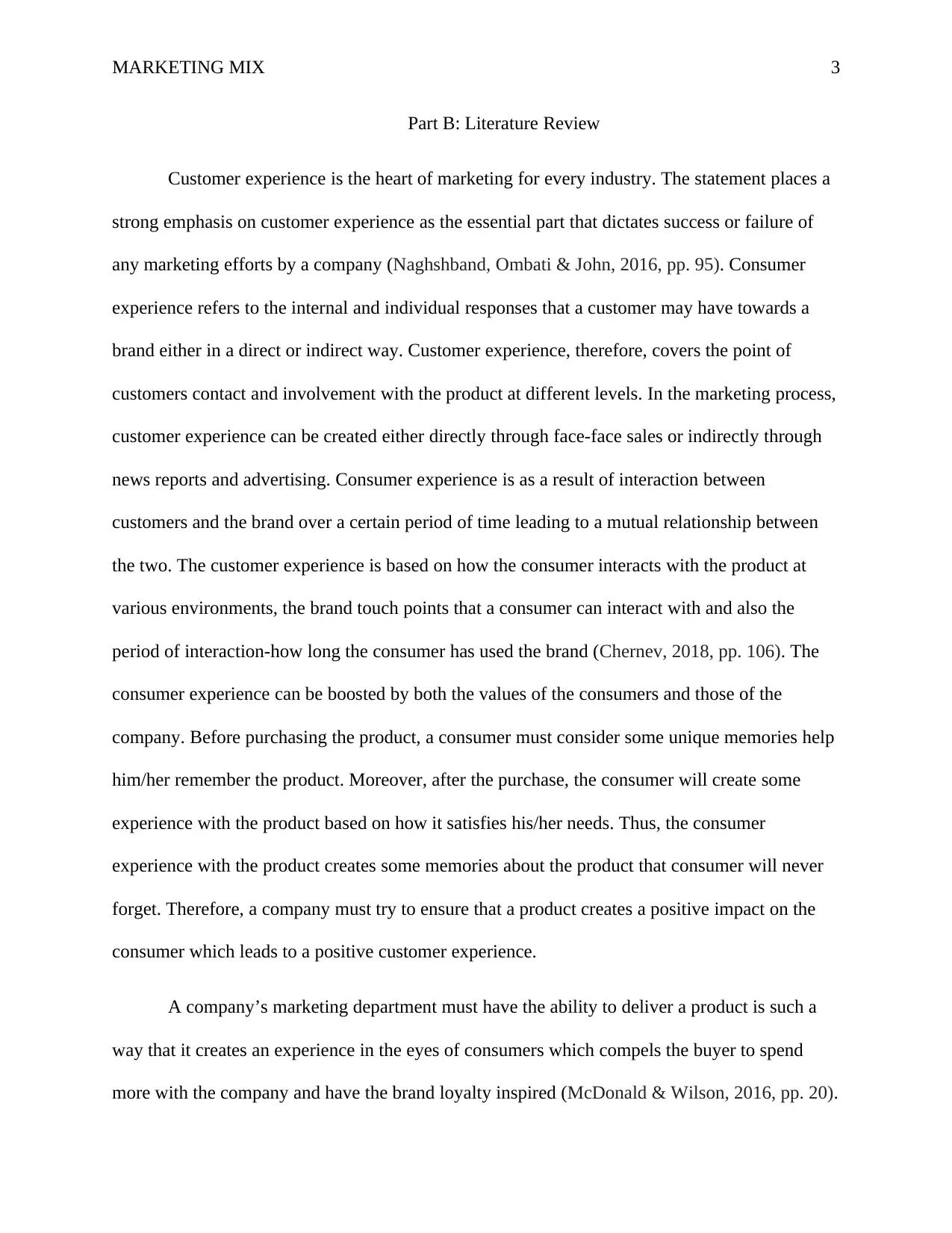
MARKETING MIX 3
Part B: Literature Review
Customer experience is the heart of marketing for every industry. The statement places a
strong emphasis on customer experience as the essential part that dictates success or failure of
any marketing efforts by a company (Naghshband, Ombati & John, 2016, pp. 95). Consumer
experience refers to the internal and individual responses that a customer may have towards a
brand either in a direct or indirect way. Customer experience, therefore, covers the point of
customers contact and involvement with the product at different levels. In the marketing process,
customer experience can be created either directly through face-face sales or indirectly through
news reports and advertising. Consumer experience is as a result of interaction between
customers and the brand over a certain period of time leading to a mutual relationship between
the two. The customer experience is based on how the consumer interacts with the product at
various environments, the brand touch points that a consumer can interact with and also the
period of interaction-how long the consumer has used the brand (Chernev, 2018, pp. 106). The
consumer experience can be boosted by both the values of the consumers and those of the
company. Before purchasing the product, a consumer must consider some unique memories help
him/her remember the product. Moreover, after the purchase, the consumer will create some
experience with the product based on how it satisfies his/her needs. Thus, the consumer
experience with the product creates some memories about the product that consumer will never
forget. Therefore, a company must try to ensure that a product creates a positive impact on the
consumer which leads to a positive customer experience.
A company’s marketing department must have the ability to deliver a product is such a
way that it creates an experience in the eyes of consumers which compels the buyer to spend
more with the company and have the brand loyalty inspired (McDonald & Wilson, 2016, pp. 20).
Part B: Literature Review
Customer experience is the heart of marketing for every industry. The statement places a
strong emphasis on customer experience as the essential part that dictates success or failure of
any marketing efforts by a company (Naghshband, Ombati & John, 2016, pp. 95). Consumer
experience refers to the internal and individual responses that a customer may have towards a
brand either in a direct or indirect way. Customer experience, therefore, covers the point of
customers contact and involvement with the product at different levels. In the marketing process,
customer experience can be created either directly through face-face sales or indirectly through
news reports and advertising. Consumer experience is as a result of interaction between
customers and the brand over a certain period of time leading to a mutual relationship between
the two. The customer experience is based on how the consumer interacts with the product at
various environments, the brand touch points that a consumer can interact with and also the
period of interaction-how long the consumer has used the brand (Chernev, 2018, pp. 106). The
consumer experience can be boosted by both the values of the consumers and those of the
company. Before purchasing the product, a consumer must consider some unique memories help
him/her remember the product. Moreover, after the purchase, the consumer will create some
experience with the product based on how it satisfies his/her needs. Thus, the consumer
experience with the product creates some memories about the product that consumer will never
forget. Therefore, a company must try to ensure that a product creates a positive impact on the
consumer which leads to a positive customer experience.
A company’s marketing department must have the ability to deliver a product is such a
way that it creates an experience in the eyes of consumers which compels the buyer to spend
more with the company and have the brand loyalty inspired (McDonald & Wilson, 2016, pp. 20).
⊘ This is a preview!⊘
Do you want full access?
Subscribe today to unlock all pages.

Trusted by 1+ million students worldwide
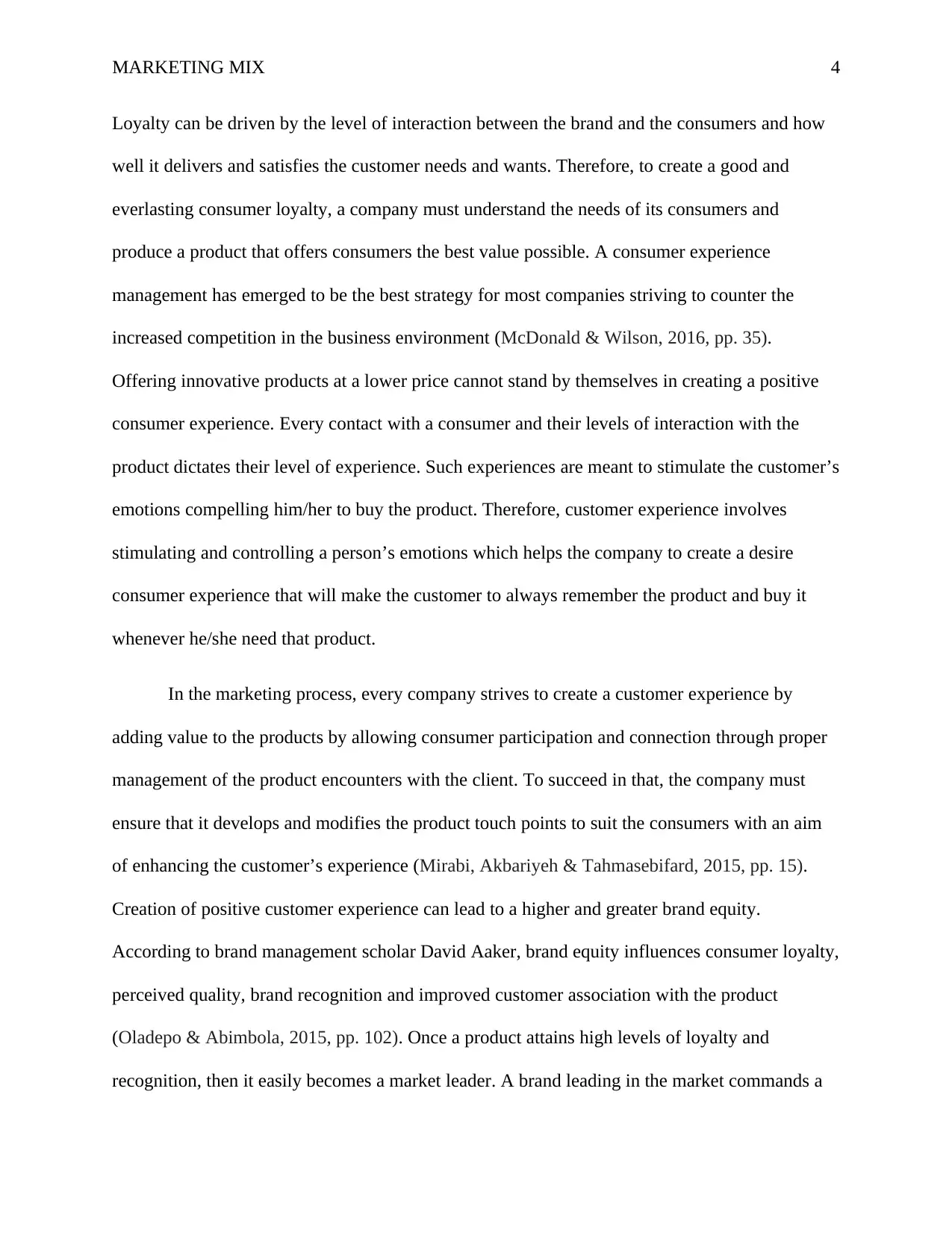
MARKETING MIX 4
Loyalty can be driven by the level of interaction between the brand and the consumers and how
well it delivers and satisfies the customer needs and wants. Therefore, to create a good and
everlasting consumer loyalty, a company must understand the needs of its consumers and
produce a product that offers consumers the best value possible. A consumer experience
management has emerged to be the best strategy for most companies striving to counter the
increased competition in the business environment (McDonald & Wilson, 2016, pp. 35).
Offering innovative products at a lower price cannot stand by themselves in creating a positive
consumer experience. Every contact with a consumer and their levels of interaction with the
product dictates their level of experience. Such experiences are meant to stimulate the customer’s
emotions compelling him/her to buy the product. Therefore, customer experience involves
stimulating and controlling a person’s emotions which helps the company to create a desire
consumer experience that will make the customer to always remember the product and buy it
whenever he/she need that product.
In the marketing process, every company strives to create a customer experience by
adding value to the products by allowing consumer participation and connection through proper
management of the product encounters with the client. To succeed in that, the company must
ensure that it develops and modifies the product touch points to suit the consumers with an aim
of enhancing the customer’s experience (Mirabi, Akbariyeh & Tahmasebifard, 2015, pp. 15).
Creation of positive customer experience can lead to a higher and greater brand equity.
According to brand management scholar David Aaker, brand equity influences consumer loyalty,
perceived quality, brand recognition and improved customer association with the product
(Oladepo & Abimbola, 2015, pp. 102). Once a product attains high levels of loyalty and
recognition, then it easily becomes a market leader. A brand leading in the market commands a
Loyalty can be driven by the level of interaction between the brand and the consumers and how
well it delivers and satisfies the customer needs and wants. Therefore, to create a good and
everlasting consumer loyalty, a company must understand the needs of its consumers and
produce a product that offers consumers the best value possible. A consumer experience
management has emerged to be the best strategy for most companies striving to counter the
increased competition in the business environment (McDonald & Wilson, 2016, pp. 35).
Offering innovative products at a lower price cannot stand by themselves in creating a positive
consumer experience. Every contact with a consumer and their levels of interaction with the
product dictates their level of experience. Such experiences are meant to stimulate the customer’s
emotions compelling him/her to buy the product. Therefore, customer experience involves
stimulating and controlling a person’s emotions which helps the company to create a desire
consumer experience that will make the customer to always remember the product and buy it
whenever he/she need that product.
In the marketing process, every company strives to create a customer experience by
adding value to the products by allowing consumer participation and connection through proper
management of the product encounters with the client. To succeed in that, the company must
ensure that it develops and modifies the product touch points to suit the consumers with an aim
of enhancing the customer’s experience (Mirabi, Akbariyeh & Tahmasebifard, 2015, pp. 15).
Creation of positive customer experience can lead to a higher and greater brand equity.
According to brand management scholar David Aaker, brand equity influences consumer loyalty,
perceived quality, brand recognition and improved customer association with the product
(Oladepo & Abimbola, 2015, pp. 102). Once a product attains high levels of loyalty and
recognition, then it easily becomes a market leader. A brand leading in the market commands a
Paraphrase This Document
Need a fresh take? Get an instant paraphrase of this document with our AI Paraphraser
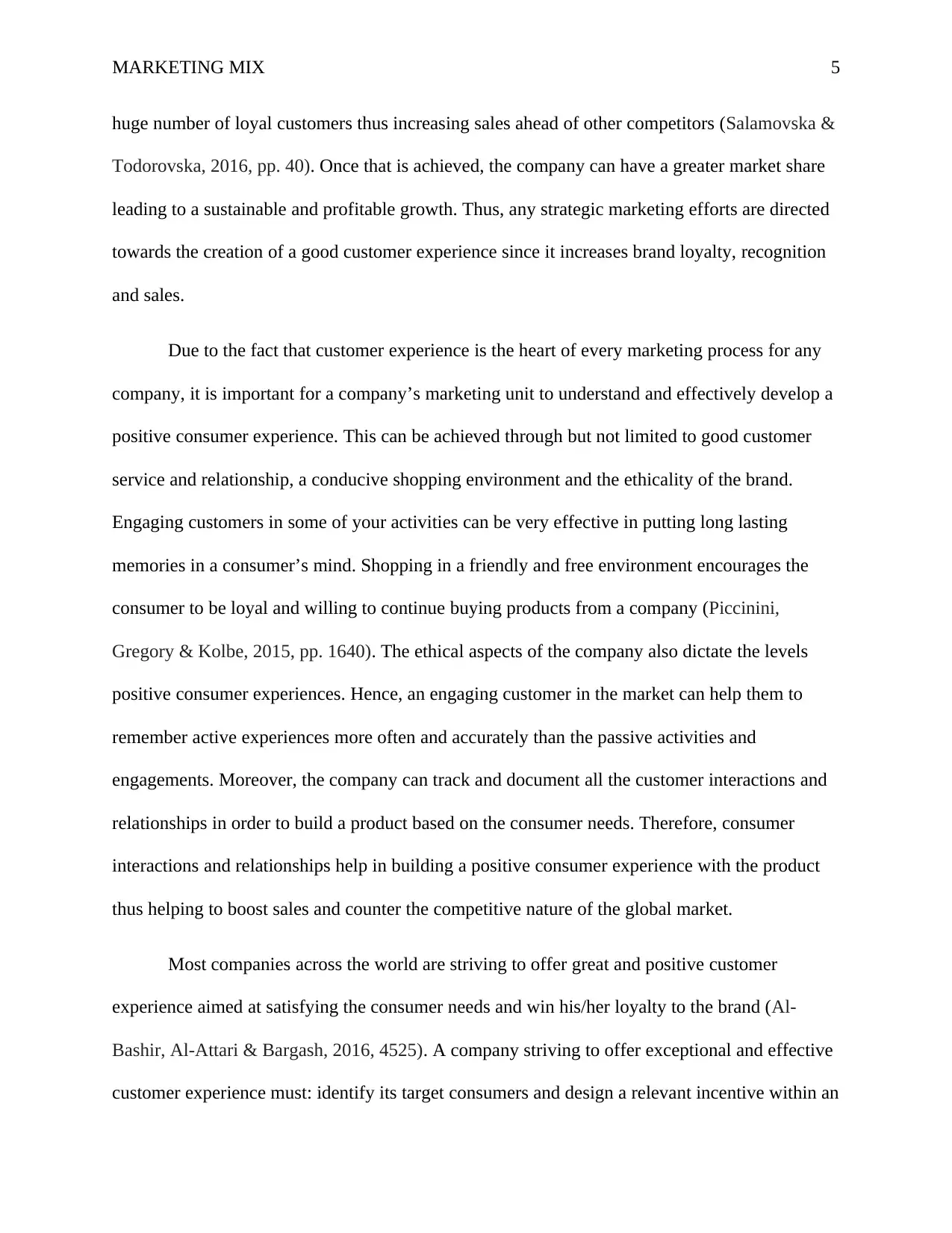
MARKETING MIX 5
huge number of loyal customers thus increasing sales ahead of other competitors (Salamovska &
Todorovska, 2016, pp. 40). Once that is achieved, the company can have a greater market share
leading to a sustainable and profitable growth. Thus, any strategic marketing efforts are directed
towards the creation of a good customer experience since it increases brand loyalty, recognition
and sales.
Due to the fact that customer experience is the heart of every marketing process for any
company, it is important for a company’s marketing unit to understand and effectively develop a
positive consumer experience. This can be achieved through but not limited to good customer
service and relationship, a conducive shopping environment and the ethicality of the brand.
Engaging customers in some of your activities can be very effective in putting long lasting
memories in a consumer’s mind. Shopping in a friendly and free environment encourages the
consumer to be loyal and willing to continue buying products from a company (Piccinini,
Gregory & Kolbe, 2015, pp. 1640). The ethical aspects of the company also dictate the levels
positive consumer experiences. Hence, an engaging customer in the market can help them to
remember active experiences more often and accurately than the passive activities and
engagements. Moreover, the company can track and document all the customer interactions and
relationships in order to build a product based on the consumer needs. Therefore, consumer
interactions and relationships help in building a positive consumer experience with the product
thus helping to boost sales and counter the competitive nature of the global market.
Most companies across the world are striving to offer great and positive customer
experience aimed at satisfying the consumer needs and win his/her loyalty to the brand (Al-
Bashir, Al-Attari & Bargash, 2016, 4525). A company striving to offer exceptional and effective
customer experience must: identify its target consumers and design a relevant incentive within an
huge number of loyal customers thus increasing sales ahead of other competitors (Salamovska &
Todorovska, 2016, pp. 40). Once that is achieved, the company can have a greater market share
leading to a sustainable and profitable growth. Thus, any strategic marketing efforts are directed
towards the creation of a good customer experience since it increases brand loyalty, recognition
and sales.
Due to the fact that customer experience is the heart of every marketing process for any
company, it is important for a company’s marketing unit to understand and effectively develop a
positive consumer experience. This can be achieved through but not limited to good customer
service and relationship, a conducive shopping environment and the ethicality of the brand.
Engaging customers in some of your activities can be very effective in putting long lasting
memories in a consumer’s mind. Shopping in a friendly and free environment encourages the
consumer to be loyal and willing to continue buying products from a company (Piccinini,
Gregory & Kolbe, 2015, pp. 1640). The ethical aspects of the company also dictate the levels
positive consumer experiences. Hence, an engaging customer in the market can help them to
remember active experiences more often and accurately than the passive activities and
engagements. Moreover, the company can track and document all the customer interactions and
relationships in order to build a product based on the consumer needs. Therefore, consumer
interactions and relationships help in building a positive consumer experience with the product
thus helping to boost sales and counter the competitive nature of the global market.
Most companies across the world are striving to offer great and positive customer
experience aimed at satisfying the consumer needs and win his/her loyalty to the brand (Al-
Bashir, Al-Attari & Bargash, 2016, 4525). A company striving to offer exceptional and effective
customer experience must: identify its target consumers and design a relevant incentive within an
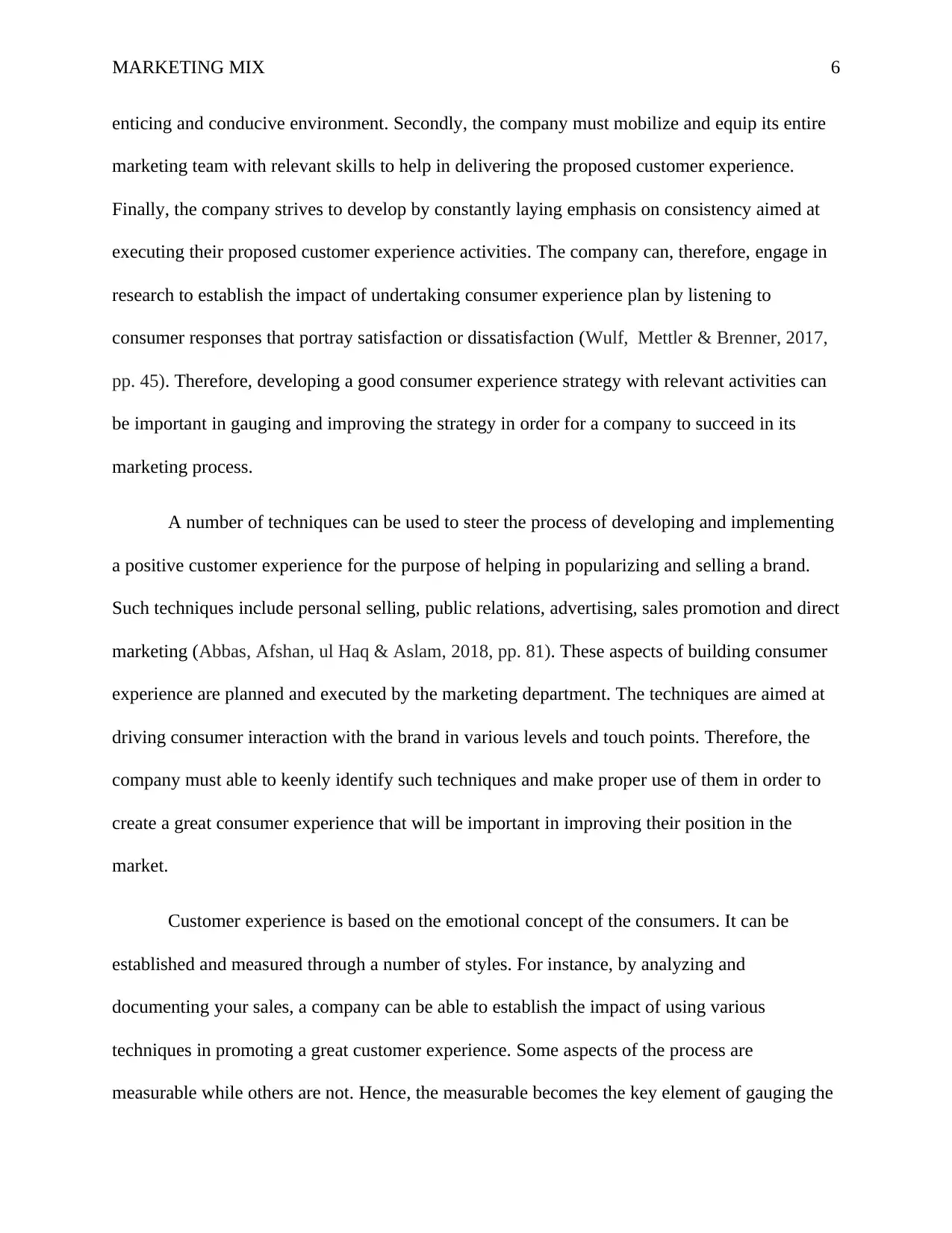
MARKETING MIX 6
enticing and conducive environment. Secondly, the company must mobilize and equip its entire
marketing team with relevant skills to help in delivering the proposed customer experience.
Finally, the company strives to develop by constantly laying emphasis on consistency aimed at
executing their proposed customer experience activities. The company can, therefore, engage in
research to establish the impact of undertaking consumer experience plan by listening to
consumer responses that portray satisfaction or dissatisfaction (Wulf, Mettler & Brenner, 2017,
pp. 45). Therefore, developing a good consumer experience strategy with relevant activities can
be important in gauging and improving the strategy in order for a company to succeed in its
marketing process.
A number of techniques can be used to steer the process of developing and implementing
a positive customer experience for the purpose of helping in popularizing and selling a brand.
Such techniques include personal selling, public relations, advertising, sales promotion and direct
marketing (Abbas, Afshan, ul Haq & Aslam, 2018, pp. 81). These aspects of building consumer
experience are planned and executed by the marketing department. The techniques are aimed at
driving consumer interaction with the brand in various levels and touch points. Therefore, the
company must able to keenly identify such techniques and make proper use of them in order to
create a great consumer experience that will be important in improving their position in the
market.
Customer experience is based on the emotional concept of the consumers. It can be
established and measured through a number of styles. For instance, by analyzing and
documenting your sales, a company can be able to establish the impact of using various
techniques in promoting a great customer experience. Some aspects of the process are
measurable while others are not. Hence, the measurable becomes the key element of gauging the
enticing and conducive environment. Secondly, the company must mobilize and equip its entire
marketing team with relevant skills to help in delivering the proposed customer experience.
Finally, the company strives to develop by constantly laying emphasis on consistency aimed at
executing their proposed customer experience activities. The company can, therefore, engage in
research to establish the impact of undertaking consumer experience plan by listening to
consumer responses that portray satisfaction or dissatisfaction (Wulf, Mettler & Brenner, 2017,
pp. 45). Therefore, developing a good consumer experience strategy with relevant activities can
be important in gauging and improving the strategy in order for a company to succeed in its
marketing process.
A number of techniques can be used to steer the process of developing and implementing
a positive customer experience for the purpose of helping in popularizing and selling a brand.
Such techniques include personal selling, public relations, advertising, sales promotion and direct
marketing (Abbas, Afshan, ul Haq & Aslam, 2018, pp. 81). These aspects of building consumer
experience are planned and executed by the marketing department. The techniques are aimed at
driving consumer interaction with the brand in various levels and touch points. Therefore, the
company must able to keenly identify such techniques and make proper use of them in order to
create a great consumer experience that will be important in improving their position in the
market.
Customer experience is based on the emotional concept of the consumers. It can be
established and measured through a number of styles. For instance, by analyzing and
documenting your sales, a company can be able to establish the impact of using various
techniques in promoting a great customer experience. Some aspects of the process are
measurable while others are not. Hence, the measurable becomes the key element of gauging the
⊘ This is a preview!⊘
Do you want full access?
Subscribe today to unlock all pages.

Trusted by 1+ million students worldwide
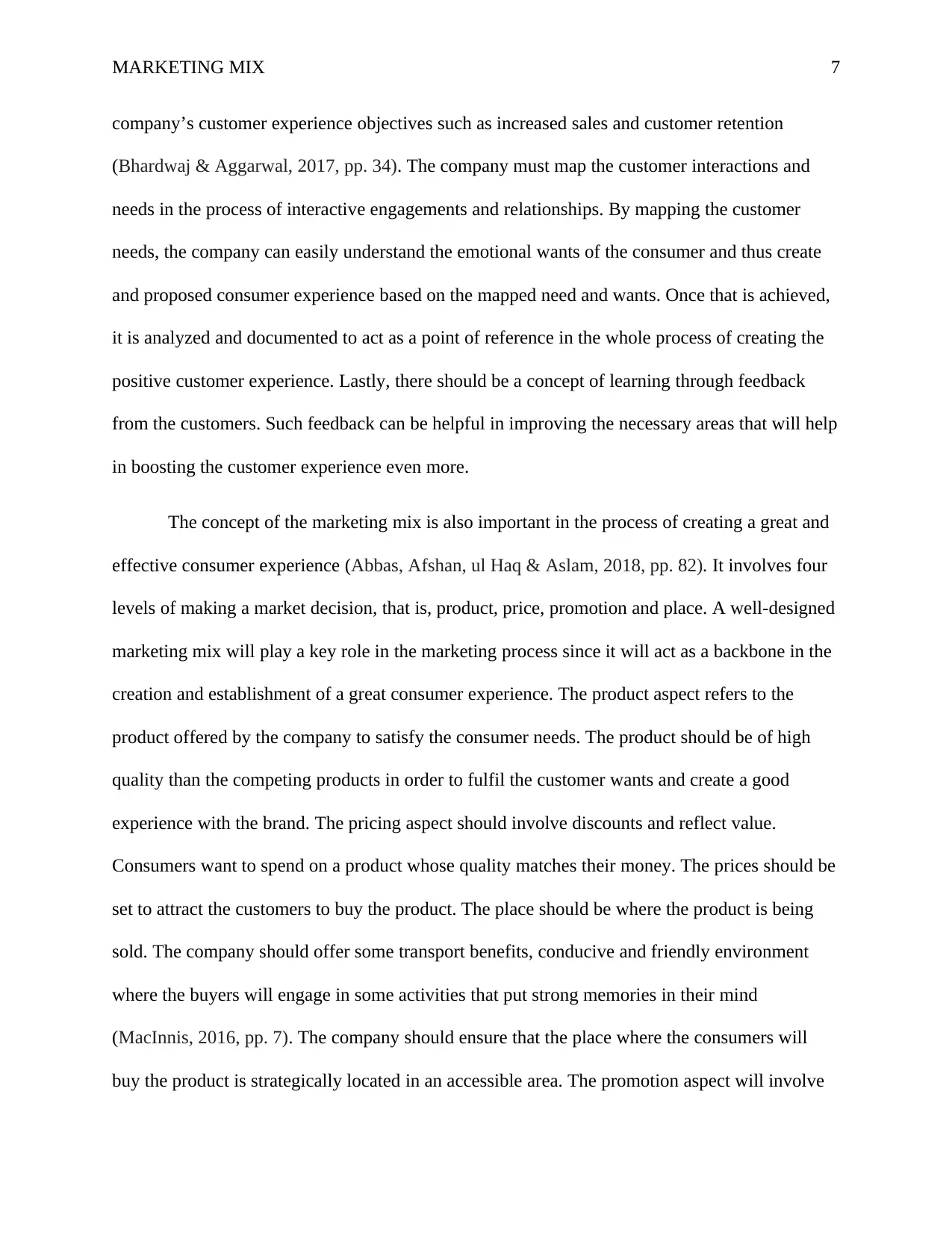
MARKETING MIX 7
company’s customer experience objectives such as increased sales and customer retention
(Bhardwaj & Aggarwal, 2017, pp. 34). The company must map the customer interactions and
needs in the process of interactive engagements and relationships. By mapping the customer
needs, the company can easily understand the emotional wants of the consumer and thus create
and proposed consumer experience based on the mapped need and wants. Once that is achieved,
it is analyzed and documented to act as a point of reference in the whole process of creating the
positive customer experience. Lastly, there should be a concept of learning through feedback
from the customers. Such feedback can be helpful in improving the necessary areas that will help
in boosting the customer experience even more.
The concept of the marketing mix is also important in the process of creating a great and
effective consumer experience (Abbas, Afshan, ul Haq & Aslam, 2018, pp. 82). It involves four
levels of making a market decision, that is, product, price, promotion and place. A well-designed
marketing mix will play a key role in the marketing process since it will act as a backbone in the
creation and establishment of a great consumer experience. The product aspect refers to the
product offered by the company to satisfy the consumer needs. The product should be of high
quality than the competing products in order to fulfil the customer wants and create a good
experience with the brand. The pricing aspect should involve discounts and reflect value.
Consumers want to spend on a product whose quality matches their money. The prices should be
set to attract the customers to buy the product. The place should be where the product is being
sold. The company should offer some transport benefits, conducive and friendly environment
where the buyers will engage in some activities that put strong memories in their mind
(MacInnis, 2016, pp. 7). The company should ensure that the place where the consumers will
buy the product is strategically located in an accessible area. The promotion aspect will involve
company’s customer experience objectives such as increased sales and customer retention
(Bhardwaj & Aggarwal, 2017, pp. 34). The company must map the customer interactions and
needs in the process of interactive engagements and relationships. By mapping the customer
needs, the company can easily understand the emotional wants of the consumer and thus create
and proposed consumer experience based on the mapped need and wants. Once that is achieved,
it is analyzed and documented to act as a point of reference in the whole process of creating the
positive customer experience. Lastly, there should be a concept of learning through feedback
from the customers. Such feedback can be helpful in improving the necessary areas that will help
in boosting the customer experience even more.
The concept of the marketing mix is also important in the process of creating a great and
effective consumer experience (Abbas, Afshan, ul Haq & Aslam, 2018, pp. 82). It involves four
levels of making a market decision, that is, product, price, promotion and place. A well-designed
marketing mix will play a key role in the marketing process since it will act as a backbone in the
creation and establishment of a great consumer experience. The product aspect refers to the
product offered by the company to satisfy the consumer needs. The product should be of high
quality than the competing products in order to fulfil the customer wants and create a good
experience with the brand. The pricing aspect should involve discounts and reflect value.
Consumers want to spend on a product whose quality matches their money. The prices should be
set to attract the customers to buy the product. The place should be where the product is being
sold. The company should offer some transport benefits, conducive and friendly environment
where the buyers will engage in some activities that put strong memories in their mind
(MacInnis, 2016, pp. 7). The company should ensure that the place where the consumers will
buy the product is strategically located in an accessible area. The promotion aspect will involve
Paraphrase This Document
Need a fresh take? Get an instant paraphrase of this document with our AI Paraphraser
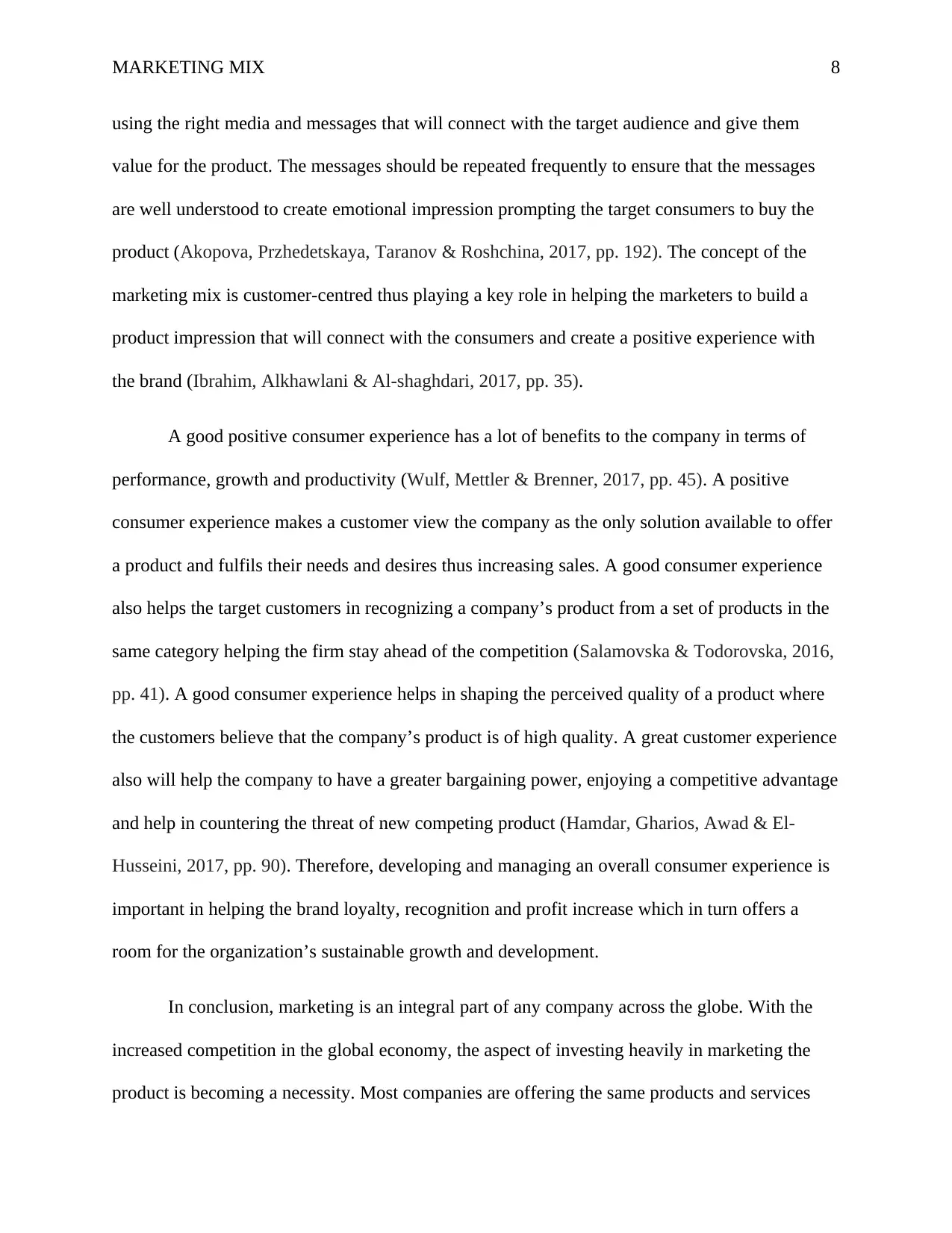
MARKETING MIX 8
using the right media and messages that will connect with the target audience and give them
value for the product. The messages should be repeated frequently to ensure that the messages
are well understood to create emotional impression prompting the target consumers to buy the
product (Akopova, Przhedetskaya, Taranov & Roshchina, 2017, pp. 192). The concept of the
marketing mix is customer-centred thus playing a key role in helping the marketers to build a
product impression that will connect with the consumers and create a positive experience with
the brand (Ibrahim, Alkhawlani & Al-shaghdari, 2017, pp. 35).
A good positive consumer experience has a lot of benefits to the company in terms of
performance, growth and productivity (Wulf, Mettler & Brenner, 2017, pp. 45). A positive
consumer experience makes a customer view the company as the only solution available to offer
a product and fulfils their needs and desires thus increasing sales. A good consumer experience
also helps the target customers in recognizing a company’s product from a set of products in the
same category helping the firm stay ahead of the competition (Salamovska & Todorovska, 2016,
pp. 41). A good consumer experience helps in shaping the perceived quality of a product where
the customers believe that the company’s product is of high quality. A great customer experience
also will help the company to have a greater bargaining power, enjoying a competitive advantage
and help in countering the threat of new competing product (Hamdar, Gharios, Awad & El-
Husseini, 2017, pp. 90). Therefore, developing and managing an overall consumer experience is
important in helping the brand loyalty, recognition and profit increase which in turn offers a
room for the organization’s sustainable growth and development.
In conclusion, marketing is an integral part of any company across the globe. With the
increased competition in the global economy, the aspect of investing heavily in marketing the
product is becoming a necessity. Most companies are offering the same products and services
using the right media and messages that will connect with the target audience and give them
value for the product. The messages should be repeated frequently to ensure that the messages
are well understood to create emotional impression prompting the target consumers to buy the
product (Akopova, Przhedetskaya, Taranov & Roshchina, 2017, pp. 192). The concept of the
marketing mix is customer-centred thus playing a key role in helping the marketers to build a
product impression that will connect with the consumers and create a positive experience with
the brand (Ibrahim, Alkhawlani & Al-shaghdari, 2017, pp. 35).
A good positive consumer experience has a lot of benefits to the company in terms of
performance, growth and productivity (Wulf, Mettler & Brenner, 2017, pp. 45). A positive
consumer experience makes a customer view the company as the only solution available to offer
a product and fulfils their needs and desires thus increasing sales. A good consumer experience
also helps the target customers in recognizing a company’s product from a set of products in the
same category helping the firm stay ahead of the competition (Salamovska & Todorovska, 2016,
pp. 41). A good consumer experience helps in shaping the perceived quality of a product where
the customers believe that the company’s product is of high quality. A great customer experience
also will help the company to have a greater bargaining power, enjoying a competitive advantage
and help in countering the threat of new competing product (Hamdar, Gharios, Awad & El-
Husseini, 2017, pp. 90). Therefore, developing and managing an overall consumer experience is
important in helping the brand loyalty, recognition and profit increase which in turn offers a
room for the organization’s sustainable growth and development.
In conclusion, marketing is an integral part of any company across the globe. With the
increased competition in the global economy, the aspect of investing heavily in marketing the
product is becoming a necessity. Most companies are offering the same products and services
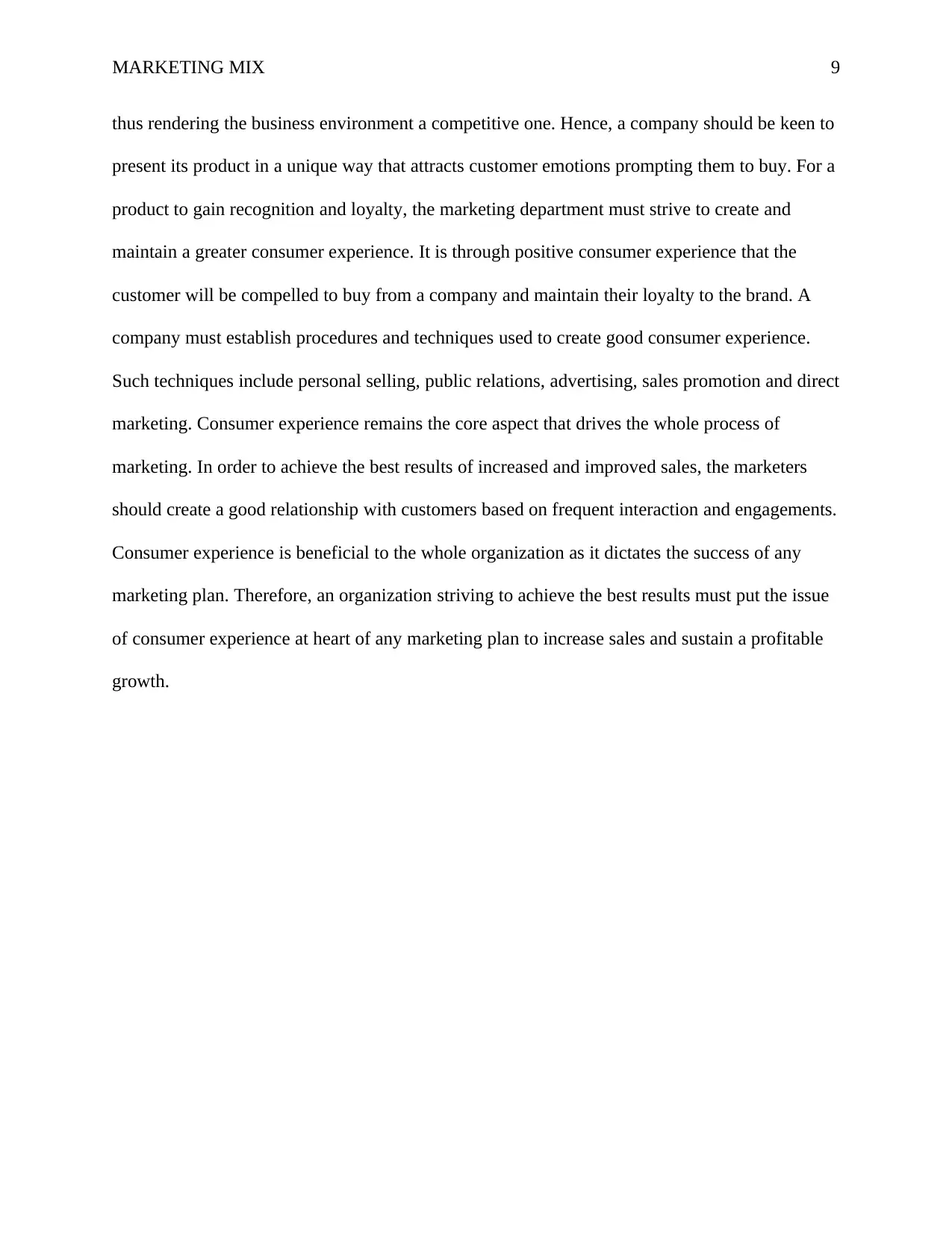
MARKETING MIX 9
thus rendering the business environment a competitive one. Hence, a company should be keen to
present its product in a unique way that attracts customer emotions prompting them to buy. For a
product to gain recognition and loyalty, the marketing department must strive to create and
maintain a greater consumer experience. It is through positive consumer experience that the
customer will be compelled to buy from a company and maintain their loyalty to the brand. A
company must establish procedures and techniques used to create good consumer experience.
Such techniques include personal selling, public relations, advertising, sales promotion and direct
marketing. Consumer experience remains the core aspect that drives the whole process of
marketing. In order to achieve the best results of increased and improved sales, the marketers
should create a good relationship with customers based on frequent interaction and engagements.
Consumer experience is beneficial to the whole organization as it dictates the success of any
marketing plan. Therefore, an organization striving to achieve the best results must put the issue
of consumer experience at heart of any marketing plan to increase sales and sustain a profitable
growth.
thus rendering the business environment a competitive one. Hence, a company should be keen to
present its product in a unique way that attracts customer emotions prompting them to buy. For a
product to gain recognition and loyalty, the marketing department must strive to create and
maintain a greater consumer experience. It is through positive consumer experience that the
customer will be compelled to buy from a company and maintain their loyalty to the brand. A
company must establish procedures and techniques used to create good consumer experience.
Such techniques include personal selling, public relations, advertising, sales promotion and direct
marketing. Consumer experience remains the core aspect that drives the whole process of
marketing. In order to achieve the best results of increased and improved sales, the marketers
should create a good relationship with customers based on frequent interaction and engagements.
Consumer experience is beneficial to the whole organization as it dictates the success of any
marketing plan. Therefore, an organization striving to achieve the best results must put the issue
of consumer experience at heart of any marketing plan to increase sales and sustain a profitable
growth.
⊘ This is a preview!⊘
Do you want full access?
Subscribe today to unlock all pages.

Trusted by 1+ million students worldwide
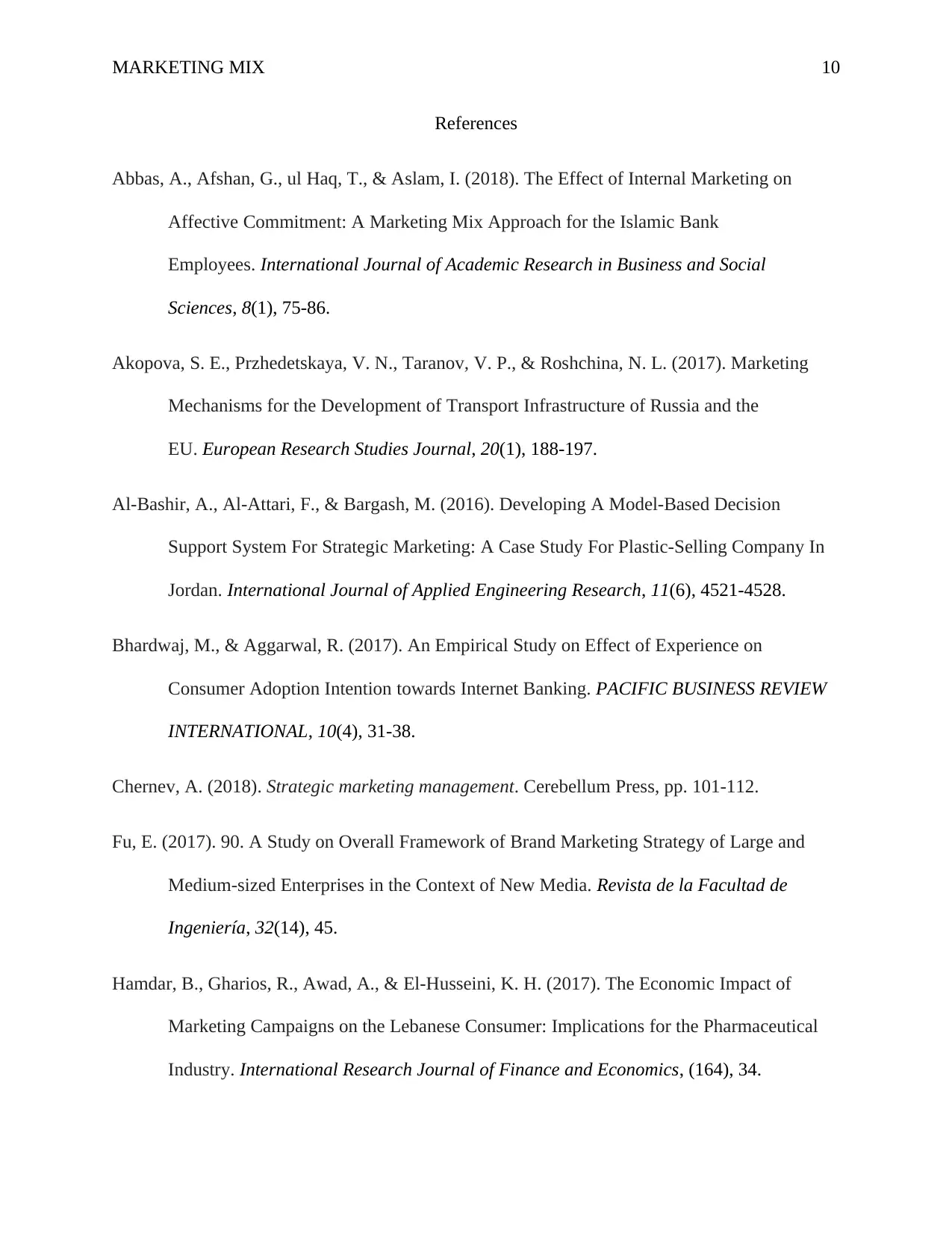
MARKETING MIX 10
References
Abbas, A., Afshan, G., ul Haq, T., & Aslam, I. (2018). The Effect of Internal Marketing on
Affective Commitment: A Marketing Mix Approach for the Islamic Bank
Employees. International Journal of Academic Research in Business and Social
Sciences, 8(1), 75-86.
Akopova, S. E., Przhedetskaya, V. N., Taranov, V. P., & Roshchina, N. L. (2017). Marketing
Mechanisms for the Development of Transport Infrastructure of Russia and the
EU. European Research Studies Journal, 20(1), 188-197.
Al-Bashir, A., Al-Attari, F., & Bargash, M. (2016). Developing A Model-Based Decision
Support System For Strategic Marketing: A Case Study For Plastic-Selling Company In
Jordan. International Journal of Applied Engineering Research, 11(6), 4521-4528.
Bhardwaj, M., & Aggarwal, R. (2017). An Empirical Study on Effect of Experience on
Consumer Adoption Intention towards Internet Banking. PACIFIC BUSINESS REVIEW
INTERNATIONAL, 10(4), 31-38.
Chernev, A. (2018). Strategic marketing management. Cerebellum Press, pp. 101-112.
Fu, E. (2017). 90. A Study on Overall Framework of Brand Marketing Strategy of Large and
Medium-sized Enterprises in the Context of New Media. Revista de la Facultad de
Ingeniería, 32(14), 45.
Hamdar, B., Gharios, R., Awad, A., & El-Husseini, K. H. (2017). The Economic Impact of
Marketing Campaigns on the Lebanese Consumer: Implications for the Pharmaceutical
Industry. International Research Journal of Finance and Economics, (164), 34.
References
Abbas, A., Afshan, G., ul Haq, T., & Aslam, I. (2018). The Effect of Internal Marketing on
Affective Commitment: A Marketing Mix Approach for the Islamic Bank
Employees. International Journal of Academic Research in Business and Social
Sciences, 8(1), 75-86.
Akopova, S. E., Przhedetskaya, V. N., Taranov, V. P., & Roshchina, N. L. (2017). Marketing
Mechanisms for the Development of Transport Infrastructure of Russia and the
EU. European Research Studies Journal, 20(1), 188-197.
Al-Bashir, A., Al-Attari, F., & Bargash, M. (2016). Developing A Model-Based Decision
Support System For Strategic Marketing: A Case Study For Plastic-Selling Company In
Jordan. International Journal of Applied Engineering Research, 11(6), 4521-4528.
Bhardwaj, M., & Aggarwal, R. (2017). An Empirical Study on Effect of Experience on
Consumer Adoption Intention towards Internet Banking. PACIFIC BUSINESS REVIEW
INTERNATIONAL, 10(4), 31-38.
Chernev, A. (2018). Strategic marketing management. Cerebellum Press, pp. 101-112.
Fu, E. (2017). 90. A Study on Overall Framework of Brand Marketing Strategy of Large and
Medium-sized Enterprises in the Context of New Media. Revista de la Facultad de
Ingeniería, 32(14), 45.
Hamdar, B., Gharios, R., Awad, A., & El-Husseini, K. H. (2017). The Economic Impact of
Marketing Campaigns on the Lebanese Consumer: Implications for the Pharmaceutical
Industry. International Research Journal of Finance and Economics, (164), 34.
Paraphrase This Document
Need a fresh take? Get an instant paraphrase of this document with our AI Paraphraser
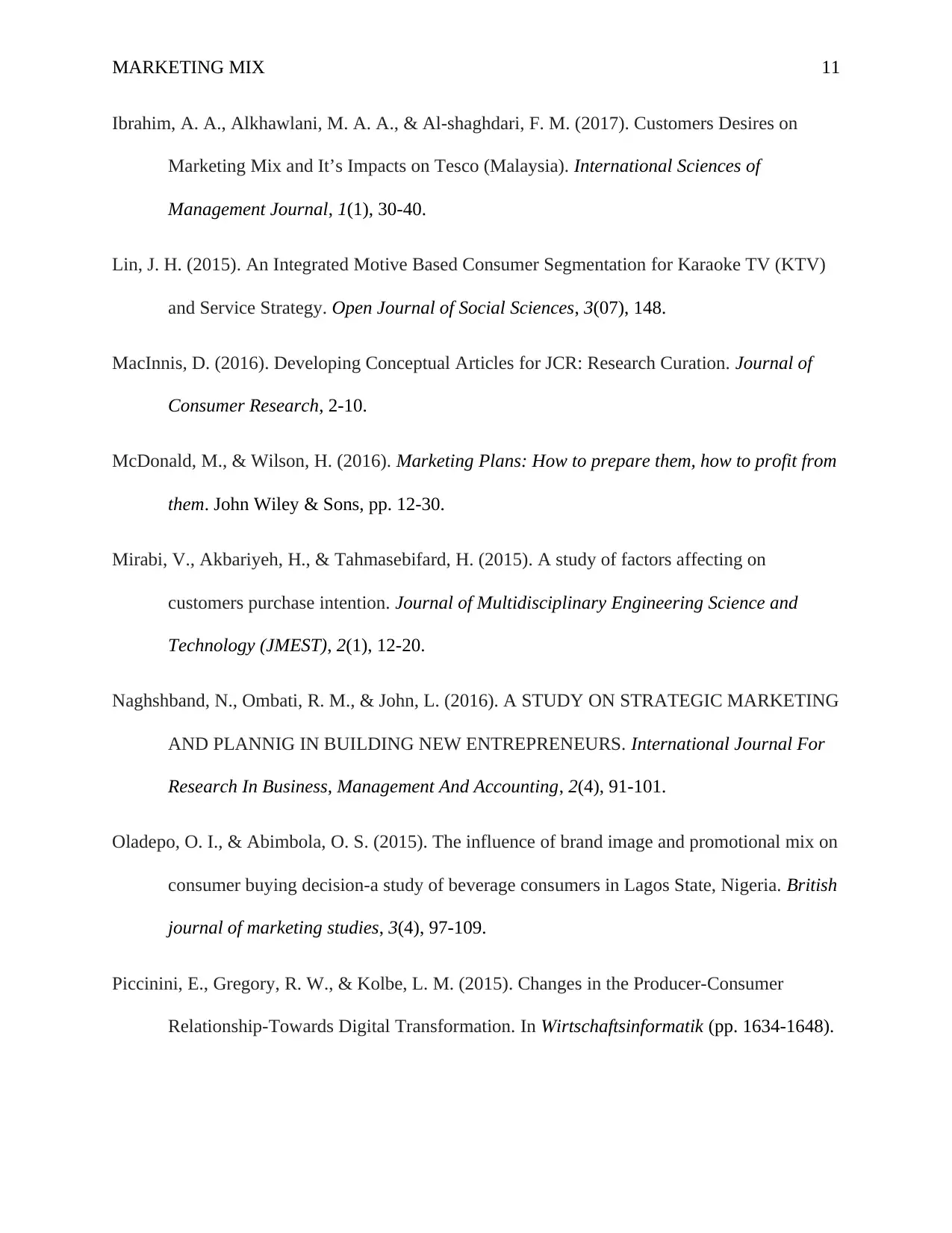
MARKETING MIX 11
Ibrahim, A. A., Alkhawlani, M. A. A., & Al-shaghdari, F. M. (2017). Customers Desires on
Marketing Mix and It’s Impacts on Tesco (Malaysia). International Sciences of
Management Journal, 1(1), 30-40.
Lin, J. H. (2015). An Integrated Motive Based Consumer Segmentation for Karaoke TV (KTV)
and Service Strategy. Open Journal of Social Sciences, 3(07), 148.
MacInnis, D. (2016). Developing Conceptual Articles for JCR: Research Curation. Journal of
Consumer Research, 2-10.
McDonald, M., & Wilson, H. (2016). Marketing Plans: How to prepare them, how to profit from
them. John Wiley & Sons, pp. 12-30.
Mirabi, V., Akbariyeh, H., & Tahmasebifard, H. (2015). A study of factors affecting on
customers purchase intention. Journal of Multidisciplinary Engineering Science and
Technology (JMEST), 2(1), 12-20.
Naghshband, N., Ombati, R. M., & John, L. (2016). A STUDY ON STRATEGIC MARKETING
AND PLANNIG IN BUILDING NEW ENTREPRENEURS. International Journal For
Research In Business, Management And Accounting, 2(4), 91-101.
Oladepo, O. I., & Abimbola, O. S. (2015). The influence of brand image and promotional mix on
consumer buying decision-a study of beverage consumers in Lagos State, Nigeria. British
journal of marketing studies, 3(4), 97-109.
Piccinini, E., Gregory, R. W., & Kolbe, L. M. (2015). Changes in the Producer-Consumer
Relationship-Towards Digital Transformation. In Wirtschaftsinformatik (pp. 1634-1648).
Ibrahim, A. A., Alkhawlani, M. A. A., & Al-shaghdari, F. M. (2017). Customers Desires on
Marketing Mix and It’s Impacts on Tesco (Malaysia). International Sciences of
Management Journal, 1(1), 30-40.
Lin, J. H. (2015). An Integrated Motive Based Consumer Segmentation for Karaoke TV (KTV)
and Service Strategy. Open Journal of Social Sciences, 3(07), 148.
MacInnis, D. (2016). Developing Conceptual Articles for JCR: Research Curation. Journal of
Consumer Research, 2-10.
McDonald, M., & Wilson, H. (2016). Marketing Plans: How to prepare them, how to profit from
them. John Wiley & Sons, pp. 12-30.
Mirabi, V., Akbariyeh, H., & Tahmasebifard, H. (2015). A study of factors affecting on
customers purchase intention. Journal of Multidisciplinary Engineering Science and
Technology (JMEST), 2(1), 12-20.
Naghshband, N., Ombati, R. M., & John, L. (2016). A STUDY ON STRATEGIC MARKETING
AND PLANNIG IN BUILDING NEW ENTREPRENEURS. International Journal For
Research In Business, Management And Accounting, 2(4), 91-101.
Oladepo, O. I., & Abimbola, O. S. (2015). The influence of brand image and promotional mix on
consumer buying decision-a study of beverage consumers in Lagos State, Nigeria. British
journal of marketing studies, 3(4), 97-109.
Piccinini, E., Gregory, R. W., & Kolbe, L. M. (2015). Changes in the Producer-Consumer
Relationship-Towards Digital Transformation. In Wirtschaftsinformatik (pp. 1634-1648).
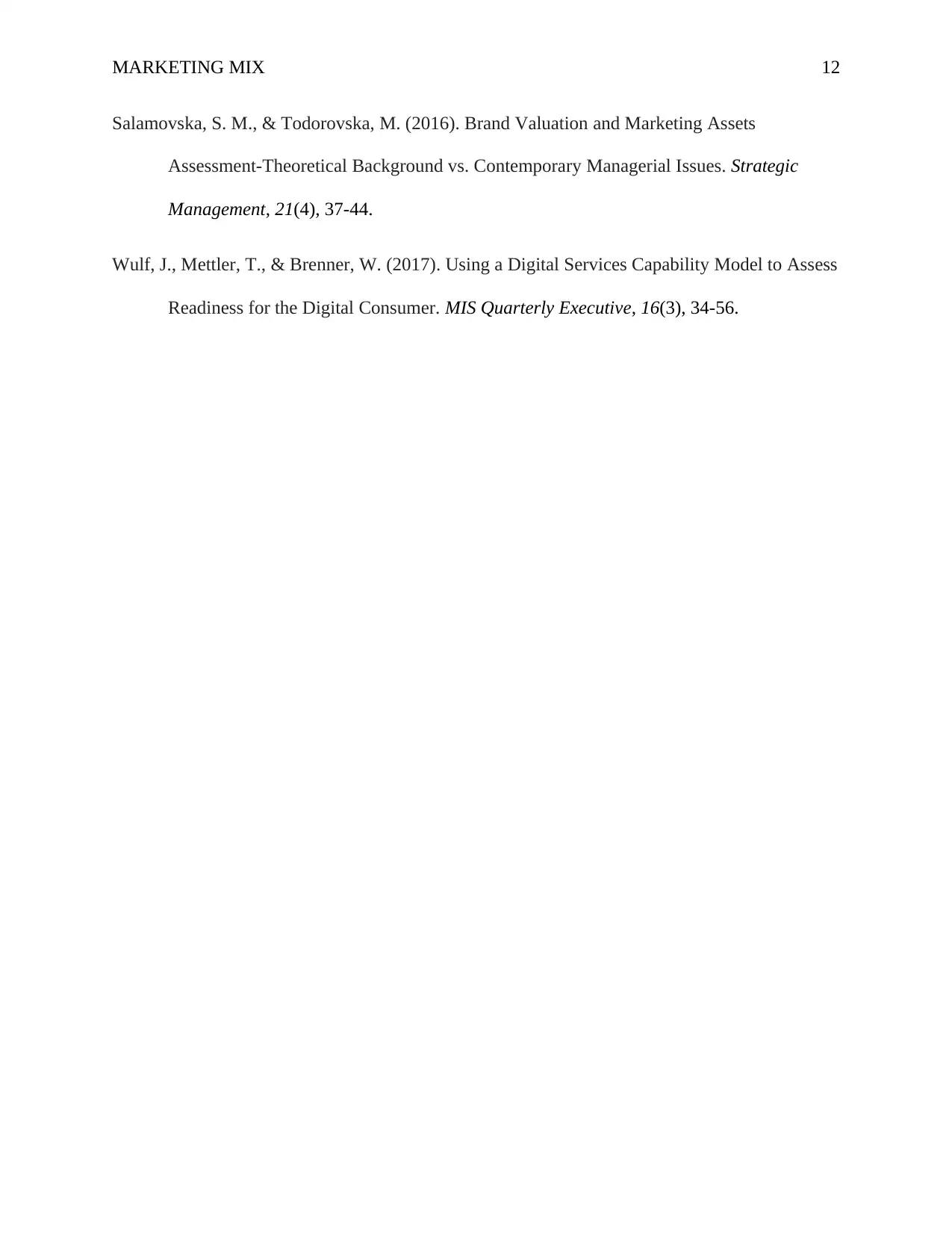
MARKETING MIX 12
Salamovska, S. M., & Todorovska, M. (2016). Brand Valuation and Marketing Assets
Assessment-Theoretical Background vs. Contemporary Managerial Issues. Strategic
Management, 21(4), 37-44.
Wulf, J., Mettler, T., & Brenner, W. (2017). Using a Digital Services Capability Model to Assess
Readiness for the Digital Consumer. MIS Quarterly Executive, 16(3), 34-56.
Salamovska, S. M., & Todorovska, M. (2016). Brand Valuation and Marketing Assets
Assessment-Theoretical Background vs. Contemporary Managerial Issues. Strategic
Management, 21(4), 37-44.
Wulf, J., Mettler, T., & Brenner, W. (2017). Using a Digital Services Capability Model to Assess
Readiness for the Digital Consumer. MIS Quarterly Executive, 16(3), 34-56.
⊘ This is a preview!⊘
Do you want full access?
Subscribe today to unlock all pages.

Trusted by 1+ million students worldwide
1 out of 12
Related Documents
Your All-in-One AI-Powered Toolkit for Academic Success.
+13062052269
info@desklib.com
Available 24*7 on WhatsApp / Email
![[object Object]](/_next/static/media/star-bottom.7253800d.svg)
Unlock your academic potential
Copyright © 2020–2025 A2Z Services. All Rights Reserved. Developed and managed by ZUCOL.





